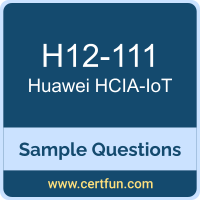 Getting knowledge of the Huawei H12-111 exam structure and question format is vital in preparing for the Huawei Certified ICT Associate - Internet of Things certification exam. Our Huawei HCIA-IoT sample questions offer you information regarding the question types and level of difficulty you will face in the real exam. The benefit of using these Huawei H12-111 sample questions is that you will get to check your preparation level or enhance your knowledge by learning the unknown questions. You will also get a clear idea of the exam environment and exam pattern you will face in the actual exam with the Huawei Certified ICT Associate - Internet of Things Sample Practice Test. Therefore, solve the Huawei HCIA-IoT sample questions to stay one step forward in grabbing the Huawei Certified ICT Associate - Internet of Things credential.
Getting knowledge of the Huawei H12-111 exam structure and question format is vital in preparing for the Huawei Certified ICT Associate - Internet of Things certification exam. Our Huawei HCIA-IoT sample questions offer you information regarding the question types and level of difficulty you will face in the real exam. The benefit of using these Huawei H12-111 sample questions is that you will get to check your preparation level or enhance your knowledge by learning the unknown questions. You will also get a clear idea of the exam environment and exam pattern you will face in the actual exam with the Huawei Certified ICT Associate - Internet of Things Sample Practice Test. Therefore, solve the Huawei HCIA-IoT sample questions to stay one step forward in grabbing the Huawei Certified ICT Associate - Internet of Things credential.
These Huawei H12-111 sample questions are simple and basic questions similar to the actual Huawei HCIA-IoT questions. If you want to evaluate your preparation level, we suggest taking our Huawei Certified ICT Associate - Internet of Things Premium Practice Test. You might face difficulties while solving the real-exam-like questions. But, you can work hard and build your confidence on the syllabus topics through unlimited practice attempts.
Huawei H12-111 Sample Questions:
a) Cloud-based
b) On-premise
c) Hybrid
d) Cost-based
a) AT+HTTP
b) AT+WIFI
c) AT+SSID
d) AT+NET
(Select two)
a) Heart rate sensors
b) Temperature sensors
c) GPS
d) Capacitive sensors
a) MCUs are less integrated and require additional external components.
b) MCUs typically integrate the CPU, memory, and peripherals on a single chip.
c) MCUs focus primarily on data storage.
d) MCUs have higher processing power and capabilities.
a) Wi-Fi
b) LTE
c) NFC
d) LoRa
a) resource
b) computational
c) network
d) electrical
a) monolithic
b) modular
d) singular
a) It supports a wide range of applications from large-scale systems to small IoT devices.
b) It is exclusive to high-end smartphones.
c) It requires extensive manual configuration.
d) It is not compatible with IoT devices.
a) 1982
b) 1990
c) 1999
d) 2005
e) 2010
(Select three)
a) Barcode
b) RFID
c) NFC
d) Li-Fi
e) GPS
Answers:
|
Question: 01 Answer: d |
Question: 02 Answer: c |
Question: 03 Answer: a, b |
Question: 04 Answer: b |
Question: 05 Answer: d |
|
Question: 06 Answer: a |
Question: 07 Answer: b |
Question: 08 Answer: a |
Question: 09 Answer: c |
Question: 10 Answer: a, b, c |
Note: For any error in Huawei Certified ICT Associate - Internet of Things (H12-111) certification exam sample questions, please update us by writing an email on feedback@certfun.com.
